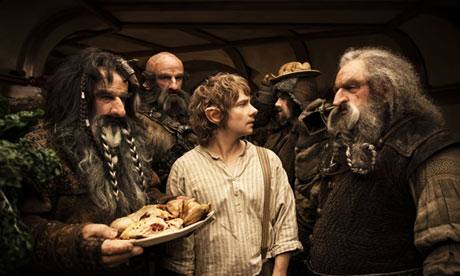
Martin Freeman (center) is a standout among a lackluster cast.
Peter Jackson’s (The Lovely Bones) Lord of the Rings trilogy was a singular cinematic achievement, a superb adaptation of a series of novels long thought unadaptable that remained faithful to its origins while wisely emphasizing its more cinematic aspects. It combined the irresistible mythological sweep of the original Star Wars trilogy with the grandeur of a David Lean movie, taking source material that easily could’ve devolved into camp or Dune-esque incomprehensibility and rendering it self-serious yet hugely enjoyable, complex yet watchable.
The Hobbit: An Unexpected Journey is not its equal. It’s a frequently entertaining, fitfully annoying, somewhat padded prequel that retains part of what made its predecessors so special while losing nearly as much and offering few unique pleasures.
In both book and film form, The Hobbit is more modest in scope than The Lord of the Rings. It’s a much slimmer novel, which makes Jackson’s decision to split it into three films, each well over two hours, all the more inexplicable.
It’s also more of a children’s story. The original trilogy was an epic, inspired by Norse and Germanic myth and concerning titanic, eschatological conflicts. It was somewhat youth-oriented, to be sure, but it was sincere, thoughtful and accessible to all age groups. An Unexpected Journey is a bedtime story, a jaunty little adventure with only hints of the darkness that gave its predecessors such weight, aimed squarely at the preteen set.
To wit: One egregiously juvenile (not to mention irrelevant) subplot concerning the Wizard Radagast (Sylvester McCoy, The Academy: Special), who lives in a tree house, has a bird’s nest on his head and rides a rabbit-pulled sleigh, feels like a lost chapter from a particularly whimsical fairy tale, not a relatively earnest and substantive fantasy series.
It’s a prelude to a bigger, more interesting story, yes – the all-important One Ring makes its debut about two hours in – but, to its credit, The Hobbit is more than pure prologue, telling its own story while setting up the conflicts unraveled in The Fellowship of the Ring in the background.
That story concerns Biblo Baggins, played by Martin Freeman (Sherlock) as a young man and LOTR vet Ian Holm (Ratatouille) in his older incarnation, who embarks – somewhat against his will – on a quest with a band of twelve Dwarves and one Wizard (Ian McKellen, The Academy: Special, reprising his role as Gandalf) to reclaim the Dwarf homeland and its many riches from a rather cruel dragon named Smaug.
Bilbo is the kind of guy who spends all his time cleaning up (rather than drinking or singing or eating) at parties and cares more about handkerchiefs and well-kept doilies than swords and treasures. He’s more enticed by the escape from normality the journey provides than he initially wishes to admit, however, and his mix of fear, frustration, excitement and wit makes him both an interesting protagonist and a good audience surrogate. (Many fans probably have more in common with the bookish Hobbit than the axe-wielding Dwarves.)
Freeman makes a solid center, and McKellen is superb as always, but the rest of the ensemble isn’t quite up to snuff. Jackson clearly spent more time detailing the Dwarves’ facial hair than their personalities, and the few that do receive any shading come off as brooding cliches – such as Richard Armitage’s (Captain America: The First Avenger) dethroned king Thorin – or as broadly cartoonish comic relief.
“Cartoonish” is, unfortunately, a word that can be applied to far too much of the film. Be warned: The Hobbit contains plenty of kid-friendly pratfalls and gross-out humor, including one joke involving copious amounts of troll mucus.
The cartoonish feel is further emphasized by Jackson’s overreliance on CGI. The Lord of the Rings had no shortage of computer animation, but that trilogy balanced it with a healthy dose of practical effects to give the films a tactile, plausible look. The world of those films had a physicality to it that The Hobbit lacks. The Orcs and Goblins of the former were, at least when in close-up, real actors in excellent makeup, giving them a realistic screen presence. In the latter, there’s very little flesh and blood and a whole lot of brightly-colored computer code.
This lends an air of the ridiculous to the action scenes. The battles play less like Arthurian high fantasy and more like slapstick, with animated heroes plowing through none-too-threatening hordes of animated villains in ways that largely disregard the laws of physics and make suspension of disbelief all the more difficult.
Jackson’s decision to shoot in 48 frames per second (as opposed to the usual 24) 3-D adds to the film’s not-quite-real visuals. The cinematography is gorgeous and amazingly detailed – Gollum’s gums subtly glisten with moisture and you can distinguish the color of individuals’ tunics from miles away – but it looks and moves in a way that’s noticeably different from normal film and normal vision. It takes more than a little getting used to and keeps you from ever getting completely immersed in the action, no matter how stunning the vistas.
Still, for everything The Hobbit does wrong, it’s hard not to get swept up in its best moments. Diminishing returns have set in with a vengeance, particularly when Jackson repurposes the same locales and the same music, but he retains the kineticism and eye for spectacle that made the original series so gob-smacking, even if he’s lost some of the heart.
He translates the novel’s best moments well – fear not, Bilbo’s encounter with the three Trolls and his fateful game of riddles are as wryly entertaining on-screen as they are in print. Jackson makes all the important stops, but he wanders too far from the path in between.
diversionsdbk@gmail.com



